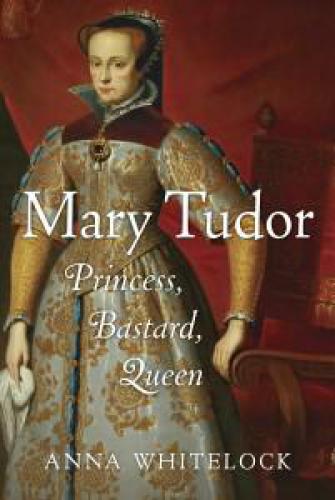
Mary Tudor
Princess, Bastard, Queen
کتاب های مرتبط
- اطلاعات
- نقد و بررسی
- دیدگاه کاربران
نقد و بررسی

July 12, 2010
Whitelock seeks to rehabilitate Henry VIII's daughter Bloody Mary (1516–1558), "one of the most reviled women in English history," and to establish her as "a political pioneer who redefined the English monarchy." University of London history lecturer Whitelock asserts that Mary Tudor's relationship with her defiant, courageous mother, Katherine of Aragon, was crucial. Mary fought hard for her crown in the only successful revolt against central government in 16th-century England. And a year later, as rebels threatened London, Mary refused to flee, rallying Londoners to her defense. A hardworking queen closely involved in policy making, Mary demonstrated that a female monarch could conduct ceremonies, such as healing rituals, performed previously only by a divinely appointed king. Several elements continue to defy Whitelock's attempts to burnish her memory: the burning alive of Protestants by the Catholic queen's orders, her phantom pregnancies, and her submission to the will of her husband, Philip II of Spain, which led England into an unpopular war with France. Readers may wish for a more detailed account of the day-to-day workings of Mary's reign in addition to her personal travails. Still, this is a perceptive portrait of a zealous queen and the larger-than-life parents and tumultuous times that shaped her. 8 pages of color photos.

May 15, 2010
Another dogged attempt to rehabilitate Bloody Mary.
Whitelock (Early Modern History/Univ. of London) does a fine job fleshing out this complex character who was destined for greatness—as the first-born of Henry VIII—yet doomed by the religious schism of the era to become"the queen of regrets." From an early age, Mary Tudor (1516–1558) was shamelessly used as a pawn in European politics by her father, betrothed alternately to the French then Spanish throne and fixed as Henry's heir then disinherited with his marriage to Anne Boleyn. Eventually Mary was cast out by her beloved father for her refusal to repudiate her mother, Katherine of Aragon, and her Catholic religion, and she was put under house arrest. However, under the threat of death, she was forced to sign"Lady Mary's Submission" acknowledging her illegitimate status and Henry as supreme head of the Church of England. Her staunchly Protestant brother Edward VI's suspicion that Mary would"provoke great disturbances after I have left this life" came swiftly to pass after his untimely death and her rocky accession to the throne in 1553. Catholic rituals were restored, Protestants and other rebels were thrown on the pyre or imprisoned, an unpopular marriage to Philip of Spain was concluded and the country was essentially torn apart. Elizabeth I had witnessed Mary's courage and defiance as Britain's first"warrior queen," and surely marveled at her intelligence, education and ability to run government affairs. Yet Elizabeth prudently forged another way, cautious in all things, keen to popular sentiment, wary of the foreign entanglements that had ensnared her sister and, above all, eschewing marriage to a husband whose power could undermine her own. Whitelock provides a lively, well-structured treatment of this major figure of British history.
Apparently books about British royalty never go out of style, even for American readers, and this is a decent addition to the genre.
(COPYRIGHT (2010) KIRKUS REVIEWS/NIELSEN BUSINESS MEDIA, INC. ALL RIGHTS RESERVED.)

July 1, 2010
In historical record and popular imagination, the Tudor queens are polarizing figures. One is either a die-hard supporter of Elizabeth I or Mary I but rarely of both. In her debut book, Whitelock unreservedly comes down on the side of Mary. Formed by her traumatic youth and her resolutely Catholic mother, Catherine of Aragon, Mary would go on to do the seemingly impossible for her time: become the first queen regnant of England. Tracing the familiar path of Mary's life from adored royal princess to bastardized daughter to popular then reviled queen, Whitelock correctly asserts that it was Mary who laid the groundwork for female rule that her younger half sister, Elizabeth, would build on such success. Not a blind apologist, Whitelock does address the brutality of Mary's "re-Catholicization" of England, in particular, the vindictive burning of Thomas Cranmer, who had performed her parents' divorce. Making no excuses for Mary's failings, Whitelock merely urges the reader to acknowledge this complex woman's achievements as well. VERDICTRecommended for readers with an interest in Tudor England, religious history, or women's history.—Tessa L.H. Minchew, Georgia Perimeter Coll. Lib., Clarkston
Copyright 2010 Library Journal, LLC Used with permission.

June 1, 2010
Queen Mary Tudor of England (who reigned from 1553 to 1558) will forever live in history as Bloody Mary, for the number of Protestants put to the flames during the reign of this unbendingly Catholic monarch. In this inviting biography, British historian Whitelock presents a more favorable queen. The eldest child of Henry VIII, Mary was initially his pampered only child, but despair over the lack of a male heir led him through a series of wives and the relegation of Mary as a bastard. As a Catholic, she experienced difficult times during the English Reformation and particularly during the brief reign of the ultra-Protestant Edward VI, her brother. Her fight to achieve the throne as Edwards rightful heir is seen here as showcasing in full color Marys mettle: her triumph over the other contestants to the throne was one of the most surprising events of the sixteenth century. The author sees survivalism in her subject, where other historians have seen only inflexibility and self-righteousness.(Reprinted with permission of Booklist, copyright 2010, American Library Association.)

























دیدگاه کاربران